Everything is illuminated
San Bartolome de Pinares, Spain -- The legendary war photographer Robert Capa once said, “if your pictures aren’t good enough, you’re not close enough.” I wonder if he’s ever photographed the Las Luminarias festival in Spain.
The ritual has unfolded on the cobbled streets of San Bartolome de Pinares for hundreds of years. On the evening of January 16, bonfires are lit throughout the streets of this village nestled in the mountains. Riders guide their horses through the flames, which are believed to purify the animal and protect him from harm. The next day, the bonfires are lit again to smoke up the streets in honor of Saint Anthony, the protector of animals.
It is just one of the countless age-old ritual and festivals that take part in towns and villages across the country and it was our first time covering this particular one.
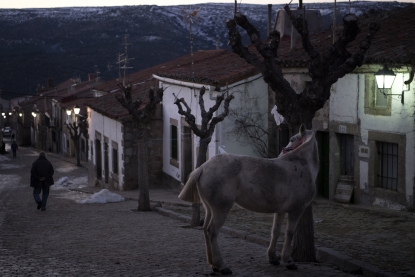 The village of San Bartolome de Pinares ahead of the festival.
(AFP / Gabriel Bouys)
The village of San Bartolome de Pinares ahead of the festival.
(AFP / Gabriel Bouys)After arriving at the village, we head to a small restaurant in front of city hall to meet Marianne’s contact and it’s here that I understand the danger in this assignment is not only going to come from the horses. The Spaniards are a welcoming lot and it would be unthinkable not to clink and have a drink with them.
Around 17:00 we watch the preparations. I’m taken aback by the love and devotion the riders are showing their animals. The whole tradition seems to me to be so brutal for the animal that seeing the affection for them is surprising.
 Braiding the horse's mane and tail to protect them from the flames.
(AFP / Gabriel Bouys)
Braiding the horse's mane and tail to protect them from the flames.
(AFP / Gabriel Bouys)Marianne: As a horse lover, I have to say I'm slightly jealous of these riders. Their horses are magnificent, really elegant, arched necks, the works... And it's true they're lovingly tended, very well kept. The horse of one of the riders is called Fiel (loyal) and he's a jittery one. He pulls back in fright when I try to pat him. Weirdly though he's fine going through the flames... How can I be more scary than a raging bonfire?!
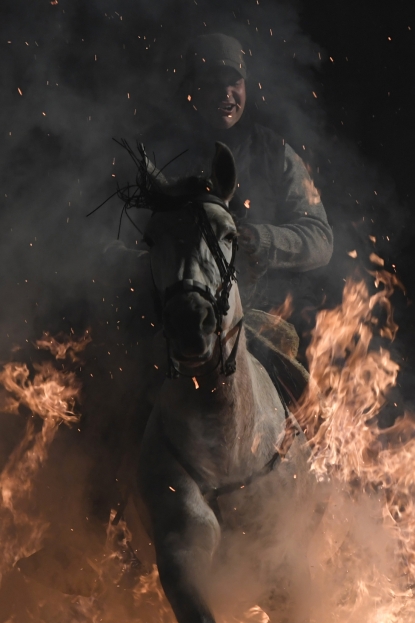 (AFP / Gabriel Bouys)
(AFP / Gabriel Bouys)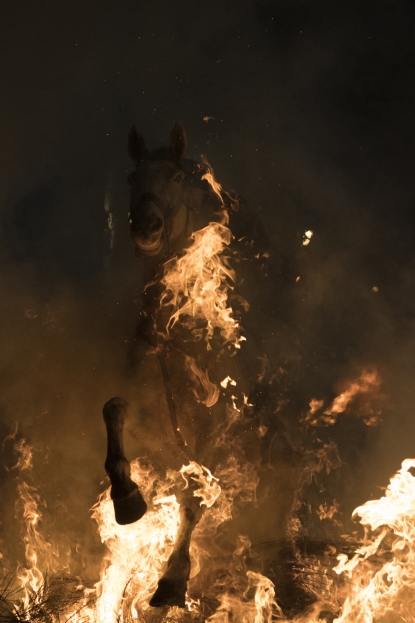 (AFP / Gabriel Bouys)
(AFP / Gabriel Bouys)
Gabriel: The villagers begin to light the bonfires around 20:00. There are a ton of people, lots of photographers. According to tradition, the riders share some wine before setting off. There doesn’t seem to be much organization, just a general sense of merriment.
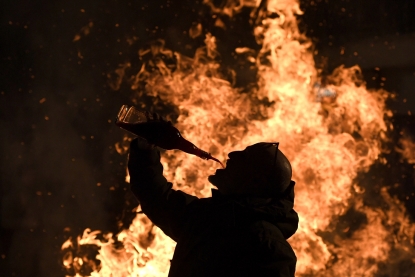 Merriment flowing all around. (AFP / Gabriel Bouys)
Merriment flowing all around. (AFP / Gabriel Bouys)The wood used to light the fires is damp (it snowed the week prior), so the smoke is thick and fills up the streets quickly. Many spectators wear masks to protect themselves from the fumes. I don’t see the first horse arriving and I wonder to myself if the rider and his steed will see me as they leap out of the flames. But to get a good photo you have to be close…
For my first spot I choose a point high in the village. It’s been nicknamed “AFP flame” by colleagues because a few years back one of our photographers in Madrid had a foot broken by a horse in this spot. A bit ominous, but it offers a good view.
The first horse arrives, goes through the flames. I click away. A few more horses pass, destroying the bonfire. There is smoke everywhere. I can hardly see anything, except the silhouettes of horses emerging from the flames. There are lots of horses making their way through the various bonfires set up throughout the village.
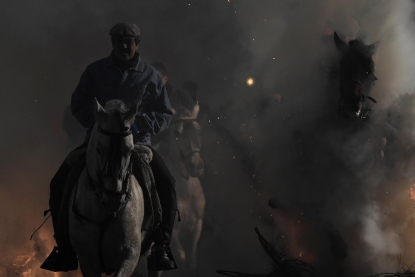 (AFP / Gabriel Bouys)
(AFP / Gabriel Bouys)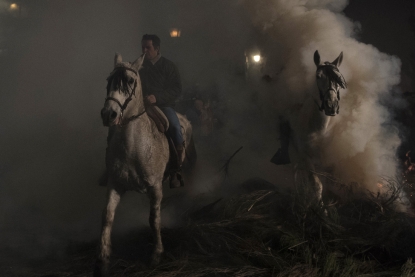 (AFP / Gabriel Bouys)
(AFP / Gabriel Bouys)
Marianne: The advantage of being a text reporter is I don't have to take Capa's advice and get so close. I look out for Gabriel from a safe distance but can't spot him through the crowd and smoke. For me, the most impressive thing is the sound of fast approaching galloping hooves, shouts of "cuidado" (careful) to those who are quickly crossing the street, and the sudden appearance of the horse and rider darting through the smoke. That's quite something. I see a couple of horses career into onlookers, one man hobbles away. By and large though, I'm astounded there aren't more injuries.
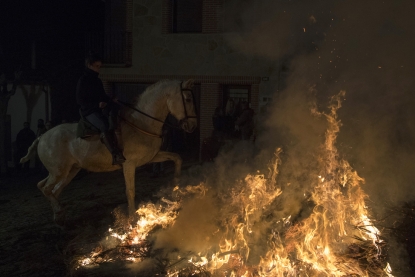 (AFP / Gabriel Bouys)
(AFP / Gabriel Bouys)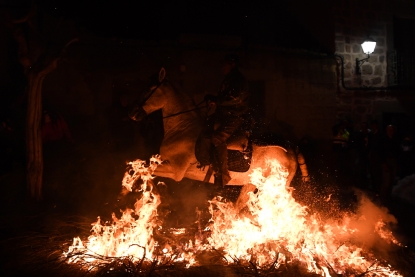 (AFP / Gabriel Bouys)
(AFP / Gabriel Bouys)
Gabriel: I choose another spot, this time on the town square, the site of the largest bonfire in the village. The crowd is dense here and I take my place next to the villagers who are feeding the bonfire. The spectacle is winding down, I feel safe in my new spot, next to a guy who’s had a bit too much red wine. And of course at that precise moment a horse bolts toward us as it leaps through the flames. This happens often during the spectacle. The villagers around me get up, none of them seems too worse for wear (the red wine must have helped ease the pain). But I tell myself that I’ve been close enough to the action and move back a bit. I’m all for getting the shot, but let’s not tempt fate.
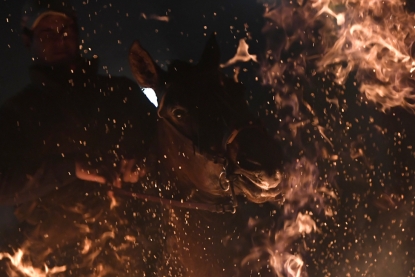 The white of its eyes. The author get uncomfortably close to a horse and rider. (AFP / Gabriel Bouys)
The white of its eyes. The author get uncomfortably close to a horse and rider. (AFP / Gabriel Bouys)Marianne: Animal rights activists hate this tradition, they feel it terrifies the horses. It's honestly hard to say. Locals tell me they would never put their beloved animals in danger and I believe them. They tend to them so well, why would they? I personally didn't see any injuries or burns, they seem to go through the fire way too quickly for that to happen. For me it's not so much the flames but the fear that one of them will fall and break a leg on the cobbled streets. Thankfully that doesn't happen...
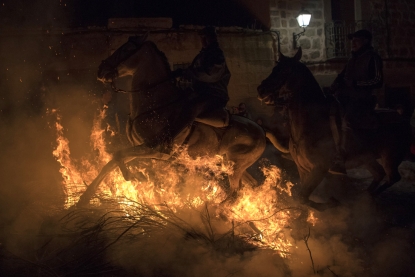 (AFP / Gabriel Bouys)
(AFP / Gabriel Bouys)Gabriel: The car smells of smoke on the ride back to Madrid. I doubt any amount of washing is going to get the smell out of our clothes. But it’s nice to know that two hours away from the Spanish capital there are events with no press service, where you can just show up and try to get as close to the crazy action as possible.
This blog was written with Yana Dlugy in Paris.
 (AFP / Gabriel Bouys)
(AFP / Gabriel Bouys) (AFP / Gabriel Bouys)
(AFP / Gabriel Bouys)




